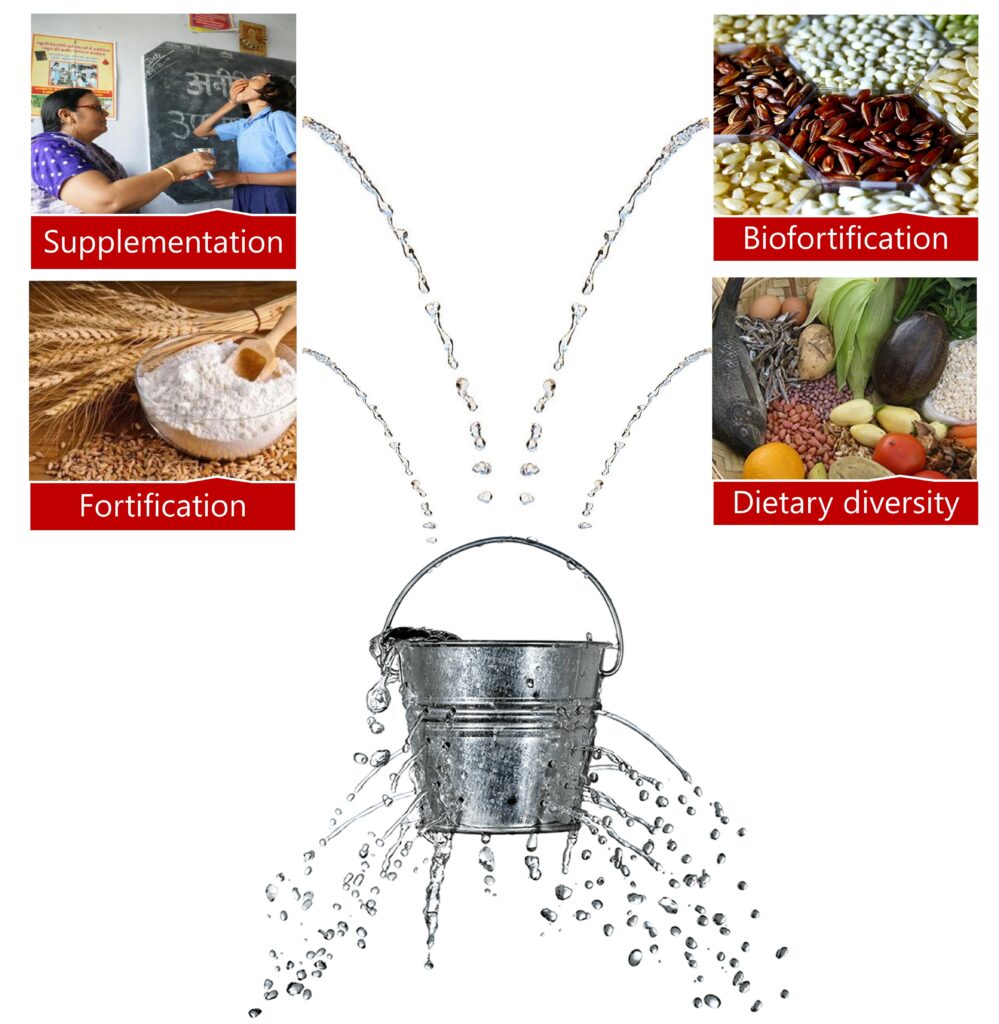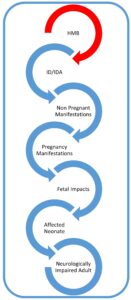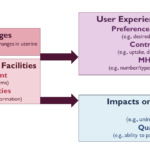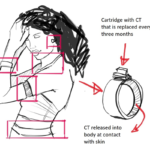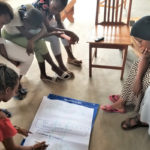Introduction
Background on anemia
Anemia occurs when a person lacks enough healthy red blood cells or hemoglobin to carry oxygen to the body’s tissues. The most common type, caused by insufficient iron in the body, leads to severe fatigue, diminished quality of life, poor birth outcomes, and increased maternal morbidity and mortality. Traditional approaches involving food fortification and iron supplementation have not yielded widespread success. This is because iron-deficiency anemia is caused by a complex web of factors, including poor nutrition, infectious disease, pregnancy, and blood loss and therefore requires a complex set of interventions.
Exploring the intersection between anemia and contraceptives
To further explore this intersection, FHI 360 recently hosted a consultation on the role of contraception in preventing and managing anemia. The team compiled an annotated bibliography in the lead-up to this event, which revealed substantial research (60 articles were included) related to hormonal contraception, iron deficiency, and iron deficiency anemia published since the year 2000.
Three notable gaps were identified:
- Research has predominantly focused on the impacts of the hormonal IUD and oral contraceptive pills, but less attention has been paid to the impact of injectables and implants, two methods that are very common in low-and-middle-income countries.
- Much of the research has focused on the impact of hormonal contraceptive use on those with heavy menstrual bleeding, with less exploration of its effects on those with typical menstruation.
- Adolescents, a high-risk population with both elevated anemia rates and high unmet need for contraception, require more dedicated research.
In addition to this look at past research, the consultation featured a panel that highlighted ongoing related research in this space, which has not yet been published in the peer-reviewed literature. This ongoing work includes a wide range of research being conducted with a diverse set of populations.
Several groups highlighted relevant clinical trials being conducted, including a study examining anemia, menstruation, and ibuprofen as a treatment in adolescents in Malawi being carried out by Dr. Hans Verhoef and Kesso van Zutphen from Wageningen University in The Netherlands. In this study and all of his work, Dr. Verhoef aims to challenge those working in the field of nutrition to focus on addressing menstrual blood loss (in other words iron loss), in addition to their work on food fortification and iron supplementation (in other words iron gain). He describes their current approaches as “pouring water into a leaky bucket.” (see Figure 1)
Dr. David Hubacher from FHI 360 presented on randomized control trial called LISA being conducted in partnership with the University of Nairobi’s Institute of Tropical & Infectious Diseases. The study will follow 600 low-income anemic women living in Kangemi, an informal settlement in Nairobi, to better understand the effects of the hormonal IUD on hemoglobin and iron stores over the course of 18 months. This study fills a research gap because it looks at the impact of hormonal contraception on anemia in a typically menstruating population, rather than the population of heavy menstrual bleeders where much of the past research has focused.
Other presenters highlighted plans for review research. Dr. Ilana Cliffer and Dr. Cara Yelverton from Harvard University are in the beginning stages of a systematic review examining family planning and nutrition outcomes among women of reproductive age in low- and middle-income countries, including outcomes related to iron-deficiency anemia. This review will add to what we learned from the annotated bibliography above. They will take a more systematic approach to summarizing what the research can and cannot tell us about the impact of contraception on anemia. This team is also looking at other nutrition outcomes and could potentially identify additional areas for collaboration between the fields of family planning and nutrition.
Stephanie Chung and Martina Xiomara Spain from FHI 360 presented preliminary findings from an analysis of the relationship between hormonal contraceptive use and anemia from 45 countries’ Demographic Health Surveys (DHS). This research is simple and straightforward because it taps into a data set that is global and publicly available, and it helps fill a gap by looking at the impact of implants and injectables on anemia, rather than focusing on only pills or IUDs.
Finally, there were several presenters who highlighted their work related to bleeding disorders, and the advocacy they are doing in parallel to their research to bring more attention and funding to this space. This included a presentation from Dr. Maureen Baldwin of OSHU, highlighting her research from an interdisciplinary menstrual clinic serving adolescents in Oregon, as well as her work with the Foundation for Women and Girls with Bleeding Disorders. Dr. Baldwin offered an example of how hormonal contraception can and is being used in the clinical setting to help patients managing bleeding disorders that result in anemia, a population that is often not being diagnosed and not receiving the care they need. She emphasized the promise research holds for this population, and the need for additional research to support and better guide clinicians.
Dr. Malcom Munro provided an overview of a recent special issue of the International Journal of Obstetrics and Gynecology overviewing the “silent pandemic” of abnormal uterine bleeding and iron deficiency. He discussed the often-over-looked pathway between heavy menstrual bleeding and iron-deficiency, impacts on people pre-pregnancy, impacts on pregnancy, impacts on fetal, neonatal, and infant development, and finally the impacts on those children as they grow into adults (see Figure 2). He also emphasized that this pathway often begins with undiagnosed and untreated heavy menstrual bleeding and anemia due, in part, to the fact that symptoms like fatigue and difficult period symptoms are normalized. This calls for further efforts to destigmatize and provide education about menstruation.
- Iron-deficiency anemia is an extremely complex issue. It will take a multi-dimensional, cross-sectoral approach to achieve global goals related to anemia reduction. Hormonal contraception is just one, important piece to this puzzle.
- There is a need for better diagnostics for iron-deficiency and iron-deficiency anemia, as well as a need to identify patients with bleeding disorders, including heavy menstrual bleeding, more accurately and consistently.
- There is consensus that the field of nutrition needs to focus more attention on addressing iron loss in addition to their efforts to improved iron intake.
- Heavy menstrual bleeding is at the center of the connection between anemia and contraception. Heavy menstrual bleeding is under-researched, especially in LMICs. To address this, we need to both address menstrual stigma and advocate for more funding and work in field of menstrual health.
- It is essential to keep reproductive autonomy at the center of this conversation. The desire of program implementors, clinicians, and policymakers to address anemia should not interfere with informed choice.
This consultation provided a venue for researchers to present their work, draw connections, identify overlaps, and brainstorm potential areas for collaboration. While opportunities like this are crucial for sharing knowledge and advancing fields of research, these conversations often happen in silos. This consultation broke these siloes and brought together individuals who seldom cross paths. Additionally, this work has highlighted the need for collaboration and integration between the fields of nutrition and family planning. It also makes one wonder who else isn’t talking to one other? Where else do we need to dismantle siloes and encourage integration?
If you are a researcher trying to tackle a persistent health issue, and current approaches are not moving the needle, it might help to look to other fields for ideas and partnership. This might just spark an idea that could grow into an impactful flame.
If you are interested in the topic of contraception and anemia or would like to learn more about the process of bringing two fields of research together, please reach out to Emily Hoppes, ehoppes@fhi360.org.


